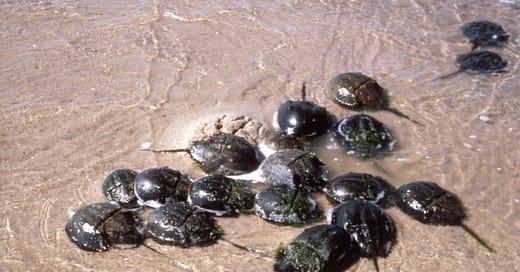At an Ancient Orgy
From an upcoming novel, "The Inside Scoop". Your comments, "likes" and subscriptions will help others find and read this page. Thanks!
Chapter 43
At an Ancient Orgy
Slaughter Beach, Delaware
June 9, 2025
The moon was full. There was no wind. There were no sounds save for the quiet lapping of waves against the shore.
Ericka and Winnie Hallwachs found themselves whispering silently under the lambent moon.
“I’m so glad you could come here to see our spawning crabs.”
W. “Remember, I’m a bug girl. It’s always good to see so many arachnids all in one place.”
E. “I like to call this one of nature’s greatest spectacles, close to a billion horseshoe crabs come ashore to lay their eggs under the full moon. Some say it’s the largest migration of any species on our planet.”
W. “And I flew to Africa to see the annual wildebeest migration. Their numbers paled in comparison!”
E. “Yup and you could have saved a fortune! But let’s see what’s going on.”
They slipped into the quiet waters. It was like diving back in time. The dark forms of a large female horseshoe crabs loomed out of the silvery luminescence and were soon joined by a suite of suitors eager to fertilize the females’ eggs.
It was like diving back in time. Their Paleozoic ancestors had lumbered out of similar waters to lay their eggs before there were birds, fish, mammals, or dinosaurs to witness the event. The only thing on land were mosses, ferns, and dragon flies with three feet long wing spans.
At dawn the crabs would be joined by thousands of red knots, shorebirds who had timed their migration from Tierra Fuego north to these beaches so they could consume tons of horseshoe crab eggs.
The eggs would give them the fuel they needed to complete their migration and still have fat reserves so they could start laying eggs before insects, their food in the Arctic, were ready to hatch.
When they surfaced Ericka told Winnie, “I was fascinated by your metaphor of a forest ecosystem being like a finely tuned Swiss watch. Does it fit here?”
W. “In spades, but what you have here is the equivalent of three interacting Swiss watches, one in South America, one on these Delaware beaches and a third above the Arctic Circle.
And if one physical parameter is off in just one of those ecosystems, it can throw the whole system out of whack.”
E. “Sounds more like a cuckoo clock.”
W. “Good analogy. But what you also have is the interaction of two biological systems, an ancient species that has been unaffected by physical changes like global warming, global cooling, asteroid collisions and volcanoes for the last 450 million years, during the world’s five great extinctions.
And a new species, that somewhere back in its evolution discovered that if it stopped halfway through its migration to gorge on horseshoe crab eggs it would have the energy it needed to both finish its flight and start egg laying above the Arctic Circle.
It’s a complicated, tenuous interaction between two species, two continents and two migrations and breeding behaviors that all have to have just the right conditions to survive.”
E. “And now those conditions are rapidly unravelling. Both the Arctic and South America are getting warmer and the waters off the East Coast are having marine heat waves.
But what interests me is that while the horseshoe crabs are holding their own, red knots, are hurtling toward extinction.
Scientists who study birds wonder if the crabs might start
coming ashore earlier because of marine heat waves, while scientists who study horseshoe crabs wonder if red knots might start arriving too early because of global warming.”
W. “It’s actually way more complicated than that. Birds use daylength to trigger their migrations north, and unlike global warming or global cooling daylength stays constant year to year. While horseshoe crabs evolved an internal biological clock which has helped them survive 450 million years.”
E. “Of course we haven’t even talked about the impact of humans collecting horseshoe crabs for medical purposes and bait.”
W. “That’s your problem up here. I simply find it comforting to be witnessing a species that existed for 450 million years as our own species seems hell bent on wiping out both itself and our own unique planetary ecosystem.”




